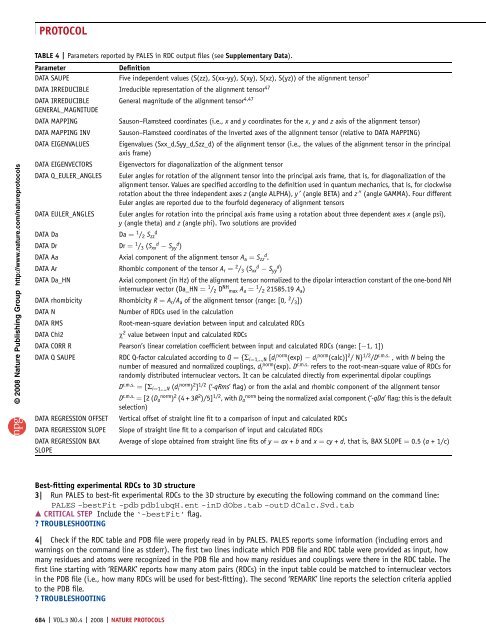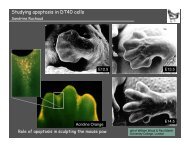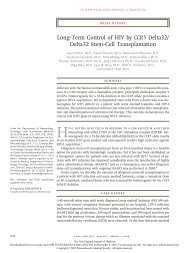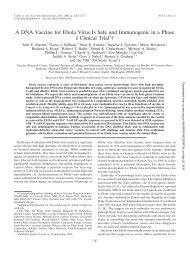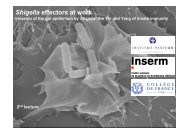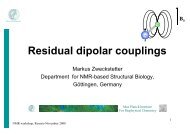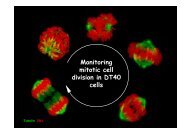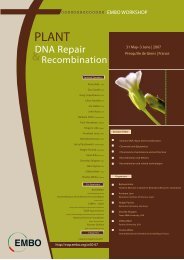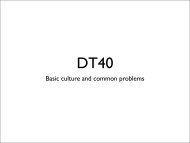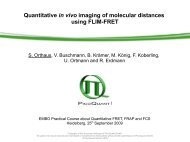b) NMR: prediction of molecular alignment from structure
b) NMR: prediction of molecular alignment from structure
b) NMR: prediction of molecular alignment from structure
Create successful ePaper yourself
Turn your PDF publications into a flip-book with our unique Google optimized e-Paper software.
© 2008<br />
Nature<br />
Publishing<br />
Group<br />
http:<br />
/ / www.<br />
nature.<br />
com/<br />
natureprotocols<br />
PROTOCOL<br />
TABLE 4 | Parameters reported by PALES in RDC output files (see Supplementary Data).<br />
Parameter Definition<br />
DATA SAUPE Five independent values (S(zz), S(xx-yy), S(xy), S(xz), S(yz)) <strong>of</strong> the <strong>alignment</strong> tensor7 DATA IRREDUCIBLE Irreducible representation <strong>of</strong> the <strong>alignment</strong> tensor47 DATA IRREDUCIBLE<br />
GENERAL_MAGNITUDE<br />
General magnitude <strong>of</strong> the <strong>alignment</strong> tensor4,47 DATA MAPPING Sauson–Flamsteed coordinates (i.e., x and y coordinates for the x, y and z axis <strong>of</strong> the <strong>alignment</strong> tensor)<br />
DATA MAPPING INV Sauson–Flamsteed coordinates <strong>of</strong> the inverted axes <strong>of</strong> the <strong>alignment</strong> tensor (relative to DATA MAPPING)<br />
DATA EIGENVALUES Eigenvalues (Sxx_d,Syy_d,Szz_d) <strong>of</strong> the <strong>alignment</strong> tensor (i.e., the values <strong>of</strong> the <strong>alignment</strong> tensor in the principal<br />
axis frame)<br />
DATA EIGENVECTORS Eigenvectors for diagonalization <strong>of</strong> the <strong>alignment</strong> tensor<br />
DATA Q_EULER_ANGLES Euler angles for rotation <strong>of</strong> the <strong>alignment</strong> tensor into the principal axis frame, that is, for diagonalization <strong>of</strong> the<br />
<strong>alignment</strong> tensor. Values are specified according to the definition used in quantum mechanics, that is, for clockwise<br />
rotation about the three independent axes z (angle ALPHA), y ¢ (angle BETA) and z 00 (angle GAMMA). Four different<br />
Euler angles are reported due to the fourfold degeneracy <strong>of</strong> <strong>alignment</strong> tensors<br />
DATA EULER_ANGLES Euler angles for rotation into the principal axis frame using a rotation about three dependent axes x (angle psi),<br />
y (angle theta) and z (angle phi). Two solutions are provided<br />
DATA Da Da ¼ 1 / 2 S d<br />
zz<br />
DATA Dr Dr ¼ 1 / 3 (S xx d S yy d )<br />
DATA Aa Axial component <strong>of</strong> the <strong>alignment</strong> tensor Aa ¼ S d<br />
zz .<br />
DATA Ar Rhombic component <strong>of</strong> the tensor Ar ¼ 2 / 3 (S d<br />
xx S d<br />
yy )<br />
DATA Da_HN Axial component (in Hz) <strong>of</strong> the <strong>alignment</strong> tensor normalized to the dipolar interaction constant <strong>of</strong> the one-bond NH<br />
internuclear vector (Da_HN ¼ 1 /2 D NH max Aa ¼ 1 /2 21585.19 Aa)<br />
DATA rhombicity Rhombicity R ¼ Ar/Aa <strong>of</strong> the <strong>alignment</strong> tensor (range: [0, 2 /3])<br />
DATA N Number <strong>of</strong> RDCs used in the calculation<br />
DATA RMS Root-mean-square deviation between input and calculated RDCs<br />
DATA Chi2 w2 value between input and calculated RDCs<br />
DATA CORR R Pearson’s linear correlation coefficient between input and calculated RDCs (range: [ 1, 1])<br />
DATA Q SAUPE RDC Q-factor calculated according to Q ¼ {Si¼1,..,N [d norm<br />
i (exp) di<br />
norm (calc)] 2 /N} 1/2 /Dr.m.s. ,withNbeing the<br />
number <strong>of</strong> measured and normalized couplings, d norm<br />
i (exp). Dr.m.s. refers to the root-mean-square value <strong>of</strong> RDCs for<br />
randomly distributed internuclear vectors. It can be calculated directly <strong>from</strong> experimental dipolar couplings<br />
Dr.m.s. ¼ [Si¼1,..,N (di norm ) 2 ] 1/2 (‘-qRms’ flag) or <strong>from</strong> the axial and rhombic component <strong>of</strong> the <strong>alignment</strong> tensor<br />
Dr.m.s. ¼ [2 (Da norm ) 2 (4 + 3R2 )/5] 1/2 ,withDa norm being the normalized axial component (‘-qDa’flag;thisisthedefault<br />
selection)<br />
DATA REGRESSION OFFSET Vertical <strong>of</strong>fset <strong>of</strong> straight line fit to a comparison <strong>of</strong> input and calculated RDCs<br />
DATA REGRESSION SLOPE Slope <strong>of</strong> straight line fit to a comparison <strong>of</strong> input and calculated RDCs<br />
DATA REGRESSION BAX<br />
SLOPE<br />
Average <strong>of</strong> slope obtained <strong>from</strong> straight line fits <strong>of</strong> y ¼ ax + b and x ¼ cy + d, thatis,BAXSLOPE¼0.5 (a + 1/c)<br />
Best-fitting experimental RDCs to 3D <strong>structure</strong><br />
3| Run PALES to best-fit experimental RDCs to the 3D <strong>structure</strong> by executing the following command on the command line:<br />
PALES -bestFit -pdb pdb1ubqH.ent -inD dObs.tab -outD dCalc.Svd.tab<br />
m CRITICAL STEP Include the ‘-bestFit’ flag.<br />
? TROUBLESHOOTING<br />
4| Check if the RDC table and PDB file were properly read in by PALES. PALES reports some information (including errors and<br />
warnings on the command line as stderr). The first two lines indicate which PDB file and RDC table were provided as input, how<br />
many residues and atoms were recognized in the PDB file and how many residues and couplings were there in the RDC table. The<br />
first line starting with ‘REMARK’ reports how many atom pairs (RDCs) in the input table could be matched to internuclear vectors<br />
in the PDB file (i.e., how many RDCs will be used for best-fitting). The second ‘REMARK’ line reports the selection criteria applied<br />
to the PDB file.<br />
? TROUBLESHOOTING<br />
684 | VOL.3 NO.4 | 2008 | NATURE PROTOCOLS


